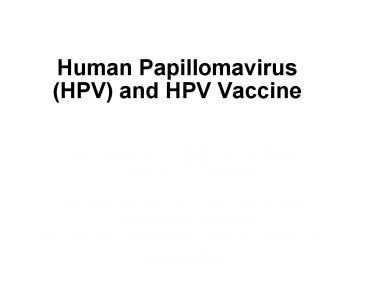Human Papillomavirus HPV and HPV Vaccine - PowerPoint PPT Presentation
1 / 23
Title:
Human Papillomavirus HPV and HPV Vaccine
Description:
More than 100 types identified based on the ... Syncope Following Vaccination ... in the number of reports of syncope has been detected by the Vaccine Adverse ... – PowerPoint PPT presentation
Number of Views:422
Avg rating:3.0/5.0
Title: Human Papillomavirus HPV and HPV Vaccine
1
- Human Papillomavirus (HPV) and HPV Vaccine
Epidemiology and Prevention of Vaccine-Preventable
Diseases National Center for Immunization and
Respiratory Diseases Centers for Disease Control
and Prevention
Revised May 2009
2
Human Papillomavirus (HPV)
- Small DNA virus
- More than 100 types identified based on the
genetic sequence of the outer capsid protein L1 - 40 types infect the mucosal epithelium
3
Human Papillomavirus Types and Disease Association
mucosal/genital(40 types)
nonmucosal/cutaneous (60 types)
high-risk types 16, 18, 31, 45 (and others)
low-risk types 6, 11 (and others)
skin warts (hands and feet)
- low grade cervical abnormalities
- cancer precursors
- anogenital cancers
- low grade cervical
- abnormalities
- genital warts
- laryngeal papillomas
4
HPV-Associated Disease
5
Natural History of HPV Infection
Within 1 Year
1-5 Years
Up to Decades
InitialHPV Infection
Persistent Infection
CIN 2/3
Cervical Cancer
CIN 1
Cleared HPV Infection
6
HPV Clinical Features
- Most HPV infections are asymptomatic and result
in no clinical disease - Clinical manifestations of HPV infection include
- anogenital warts
- recurrent respiratory papillomatosis
- cervical cancer precursors (cervical
intraepithelial neoplasia - Cancer (cervical, anal, vaginal, vulvar, penile,
and some head and neck cancer)
7
HPV Epidemiology
- Reservoir Human
- Transmission Direct contact,
- usually sexual
- Temporal None pattern
- Communicability Presumed to be high
8
HPV Disease Burden in the United States
- Anogenital HPV is the most common sexually
transmitted infection in the US - Estimated 20 million currently infected
- 6.2 million new infections/year
- Common among adolescents and young adults
- Estimated 80 of sexually active women will have
been infected by age 50 - Infection also common in men
9
Cervical Cancer Disease Burden in the United
States
- The American Cancer Society estimates that in
2008 - 11,070 new cervical cancer cases
- 3,870 cervical cancer deaths
- Almost 100 of these cervical cancer cases will
be caused by one of the 40 HPV types that infect
the mucosa
10
Cervical Cancer Screening
- Cervical cancer screening no change
- 30 of cervical cancers caused by HPV types not
prevented by the quadrivalent HPV vaccine - Vaccinated females could subsequently be infected
with non-vaccine HPV types - Sexually active females could have been infected
prior to vaccination - Providers should educate women about the
importance of cervical cancer screening
11
Human Papillomavirus Vaccine
- HPV L1 major capsid protein of the virus is
antigen used for immunization - L1 protein expressed in yeast cells using
recombinant technology - L1 proteins self-assemble into virus-like
particles (VLP) - VLPs are noninfectious and nononcogenic
12
HPV Vaccine Efficacy
Among 16-26 year old females. CIN cervical
intraepithelial neoplasia AIS adenocarcinoma
in situ
13
HPV Vaccine Efficacy
- High efficacy among females without evidence of
infection with vaccine HPV types - No evidence of efficacy against disease caused by
vaccine types or which participants were infected
at the time of vaccination - Prior infection with one HPV type did not
diminish efficacy of the vaccine against other
vaccine HPV types
14
Routine HPV Vaccination Recommendations
- ACIP recommends routine vaccination of females 11
or 12 years of age - The vaccination series can be started as young as
9 years of age at the clinicians discretion - Catch-up vaccination recommended for females 13
through 26 years of age
MMWR 200756(RR-2)1-24
15
HPV Vaccination Schedule
- Routine schedule is 0, 2, 6 months
- Third dose should follow the first dose by at
least 24 weeks - An accelerated schedule using minimum intervals
is not recommended - Series does not need to be restarted if the
schedule is interrupted
16
Human Papillomavirus Vaccine
- Quadrivalent HPV vaccine is not currently
approved for males, or for females younger than 9
years or older than 26 years - Off-label use is not recommended
- Studies of safety and efficacy among males and
females older than 26 years are ongoing
as of May 2009
17
HPV VaccineSpecial Situations
- Equivocal or abnormal Pap test
- Positive HPV DNA test
- Genital warts
- Immunosuppression
- Breastfeeding
Vaccine can be administered
18
HPV VaccineAdverse Reactions
- Local reactions 84
- (pain, swelling)
- Fever 10
- No serious adverse reactions reported
similar to reports in placebo recipients (9)
19
Syncope Following Vaccination
- An increase in the number of reports of syncope
has been detected by the Vaccine Adverse Event
Reporting System (VAERS) - 11-18 year old females have contributed most of
the increase - Serious injuries have resulted
- Providers should strongly consider observing
patients for 15 minutes after they are vaccinated
20
HPV VaccineContraindications and Precautions
- Contraindication
- Severe allergic reaction to a vaccine component
or following a prior dose - Precaution
- Moderate or severe acute illnesses (defer until
symptoms improve)
21
HPV Vaccination During Pregnancy
- Initiation of the vaccine series should be
delayed until after completion of pregnancy - If a woman is found to be pregnant after
initiating the vaccination series, remaining
doses should be delayed until after the pregnancy
- If a vaccine dose has been administered during
pregnancy, there is no indication for
intervention - Women vaccinated during pregnancy should be
reported to the Merck registry (800.986.8999)
MMWR 200756(RR-2)1-24
22
HPV Vaccine Storage and Handling
- Store at 36F-46F (2C-8C)
- Protect from light
- Do not expose to freezing temperature
- Remove from refrigeration immediately before
administration
23
CDC Vaccines and ImmunizationContact Information
- Telephone 800.CDC.INFO
- Email nipinfo_at_cdc.gov
- Website www.cdc.gov/vaccines































